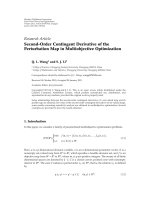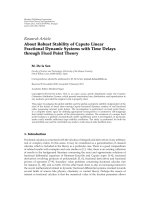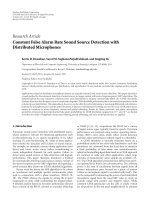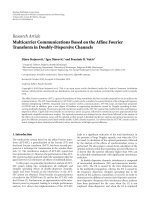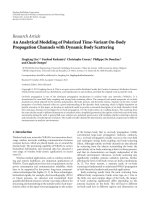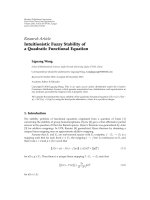Báo cáo hóa học: " Research Article Second-Order Contingent Derivative of the Perturbation Map in Multiobjective Optimization" doc
Bạn đang xem bản rút gọn của tài liệu. Xem và tải ngay bản đầy đủ của tài liệu tại đây (517.92 KB, 13 trang )
Hindawi Publishing Corporation
Fixed Point Theory and Applications
Volume 2011, Article ID 857520, 13 pages
doi:10.1155/2011/857520
Research Article
Second-Order Contingent Derivative of the
Perturbation Map in Multiobjective Optimization
Q. L. Wang
1
andS.J.Li
2
1
College of Sciences, Chongqing Jiaotong University, Chongqing 400074, China
2
College of Mathematics and Statistics, Chongqing University, Chongqing 400044, China
Correspondence should be addressed to Q. L. Wang,
Received 14 October 2010; Accepted 24 January 2011
Academic Editor: Jerzy Jezierski
Copyright q 2011 Q. L. Wang and S. J. Li. This is an open access article distributed under the
Creative Commons Attribution License, which permits unrestricted use, distribution, and
reproduction in any medium, provided the original work is properly cited.
Some relationships between the second-order contingent derivative of a set-valued map and its
profile map are obtained. By virtue of the second-order contingent derivatives of set-valued maps,
some results concerning sensitivity analysis are obtained in multiobjective optimization. Several
examples are provided to show the results obtained.
1. Introduction
In this paper, we consider a family of parametrized multiobjective optimization problems
PVOP
⎧
⎨
⎩
min f
u, x
f
1
u, x
,f
2
u, x
, ,f
m
u, x
,
s.t.u∈ X
x
⊆ R
p
.
1.1
Here, u is a p-dimensional decision variable, x is an n-dimensional parameter vector, X is a
nonempty set-valued map from R
n
to R
p
, which specifies a feasible decision set, a nd f is an
objective map from R
p
× R
n
to R
m
,wherem, n, p are positive integers. The norms of all finite
dimensional spaces are denoted by ·. C is a closed convex pointed cone with nonempty
interior in R
m
. The cone C induces a partial order ≤
C
on R
m
,thatis,therelation≤
C
is defined
by
y ≤
C
y
←→ y
− y ∈ C, ∀y, y
∈ R
m
. 1.2
2 Fixed Point Theory and Applications
We use the following notion. For any y, y
∈ R
m
,
y<
C
y
←→ y
− y ∈ int C. 1.3
Based on these notations, we can define the following two sets for a set M in R
m
:
i y
0
∈ M is a C-minimal point of M with respect to C if there exists no y ∈ M,such
that y ≤
C
y
0
, y
/
y
0
,
ii y
0
∈ M is a weakly C-minimal point of M with respect to C if there exists no y ∈ M,
such that y<
C
y
0
.
The sets of C-minimal point and weakly C-minimal point of M are denoted by Min
C
M and
WMin
C
M, respectively.
Let G be a set-valued map from R
n
to R
m
defined by
G
x
y ∈ R
m
| y f
u, x
, for some u ∈ X
x
. 1.4
Gx is considered as the feasible set map. In the vector optimization problem corresponding
to each para meter valued x,ouraimistofindthesetofC-minimal point of the feasible set
map Gx.Theset-valuedmapW from R
n
to R
m
is defined by
W
x
Min
C
G
x
, 1.5
for any x ∈ R
n
, and call it the perturbation map for PVOP.
Sensitivity and stability analysis is not only theoretically interesting but also practically
important in optimization theory. Usually, by sensitivity we mean the quantitative analysis,
that is, the study of derivatives of the perturbation function. On the other hand, by stability
we mean the qualitative analysis, that is, the study of various continuity properties of the
perturbation or marginal function or map of a family of parametrized vector optimization
problems.
Some interesting results have been proved for sensitivity and stability in optimization
see 1–16.Tanino5 obtained some results concerning sensitivity analysis in vector
optimization by using the concept of contingent derivatives of set-valued maps introduced
in 17,andShi8 and Kuk et al. 7, 11 e xtended some of Tanino’s results. As for
vector optimization with convexity assumptions, Tanino 6 studied some quantitative
and qualitative results concerning the behavior of the perturbation map, and Shi 9
studied some quantitative results concerning the behavior of the perturbation map. Li 10
discussed the continuity of contingent derivatives for set-valued maps and also discussed
the sensitivity, continuity, and closeness of the contingent derivative of the marginal map.
By virtue of lower Studniarski derivatives, Sun and Li 14 obtained some quantitative
results concerning the behavior of the weak perturbation map in parametrized vector
optimization.
Higher order derivatives introduced by the higher order tangent sets are very
important concepts in set-valued analysis. Since higher order tangent sets, in general, a re
not cones and convex sets, there are some difficulties in studying set-valued optimization
problems by virtue of the higher order derivatives or epiderivatives introduced by the higher
Fixed Point Theory and Applications 3
order tangent sets. To the best of our knowledge, second-order c ontingent derivatives of
perturbation map in multiobjective optimization have not been studied until now. Motivated
by the work reported in 5–11, 14, we discuss some second-order quantitative results
concerning the behavior of the perturbation map for PVOP.
The rest of the paper is organized as follows. In Section 2, we collect some important
concepts in this paper. In Section 3, we discuss some relationships between the second-order
contingent derivative of a set-valued map and its profile map. In Section 4, by the second-
order contingent derivative, we discuss the quantitative information on the behavior of the
perturbation map for PVOP.
2. Preliminaries
In this section, we state several important concepts.
Let F : R
n
→ 2
R
m
be nonempty set-valued maps. The efficient domain and graph of F
are defined by
dom
F
{
x ∈ R
n
| F
x
/
∅
}
,
gph
F
x, y
∈ R
n
× R
m
| y ∈ F
x
,x∈ R
n
,
2.1
respectively. The profile map F
of F is defined by F
xFxC, for every x ∈ domF,
where C is the order cone of R
m
.
Definition 2.1 see 18.AbaseforC is a nonempty convex subset Q of C with 0
R
m
/∈ clQ,
such that every c ∈ C, c
/
0
R
m
, has a unique representation of the form αb,whereb ∈ Q and
α>0.
Definition 2.2 see 19. F is said to be locally Lipschitz at x
0
∈ R
n
if there exist a real number
γ>0 and a neighborhood Ux
0
of x
0
,suchthat
F
x
1
⊆ F
x
2
γ
x
1
− x
2
B
R
m
, ∀x
1
,x
2
∈ U
x
0
, 2.2
where B
R
m
denotes the closed unit ball of the origin in R
m
.
3. Second-Order Contingent Derivatives for Set-Valued Maps
In this section, let X be a normed space supplied with a distance d,andletA be a subset of
X.Wedenotebydx, Ainf
y∈A
dx, y the distance from x to A,wherewesetdx, ∅∞.
Let Y be a real normed space, where the space Y is partially ordered by nontrivial pointed
closed convex cone C ⊂ Y. Now, we recall the definitions in 20.
4 Fixed Point Theory and Applications
Definition 3.1 see 20.LetA be a nonempty subset X, x
0
∈ clA,andu ∈ X,whereclA
denotes the closure of A.
i The second-order contingent set T
2
A
x
0
,u of A at x
0
,u is defined as
T
2
A
x
0
,u
x ∈ X |∃h
n
−→ 0
,x
n
−→ x, s.t.x
0
h
n
u h
2
n
x
n
∈ A
. 3.1
ii The second-order adjacent set T
2
A
x
0
,u of A at x
0
,u is defined as
T
2
A
x
0
,u
x ∈ X |∀h
n
−→ 0
, ∃x
n
−→ x, s.t.x
0
h
n
u h
2
n
x
n
∈ A
. 3.2
Definition 3.2 see 20.LetX, Y be normed spaces and F : X → 2
Y
be a set-valued map,
and let x
0
,y
0
∈ gphF and u, v ∈ X × Y .
i The set-valued map D
2
Fx
0
,y
0
,u,v from X to Y defined by
gph
D
2
F
x
0
,y
0
,u,v
T
2
gphF
x
0
,y
0
,u,v
, 3.3
is called second-order contingent derivative of F at x
0
,y
0
,u,v.
ii The set-valued map D
2
Fx
0
,y
0
,u,v from X to Y defined by
gph
D
2
F
x
0
,y
0
,u,v
T
2
gphF
x
0
,y
0
,u,v
, 3.4
is called second-order adjacent derivative of F at x
0
,y
0
,u,v.
Definition 3.3 see 21.TheC-domination property is said to be held for a subset H of Y if
H ⊂ Min
C
H C.
Proposition 3.4. Let x
0
,y
0
∈ gphF and u, v ∈ X × Y,then
D
2
F
x
0
,y
0
,u,v
x
C ⊆ D
2
F C
x
0
,y
0
,u,v
x
,
3.5
for any x ∈ X.
Proof. The conclusion can be directly obtained similarly as the proof of 5,Proposition2.1.
It follows from Proposition 3.4 that
dom
D
2
F
x
0
,y
0
,u,v
⊆ dom
D
2
F
x
0
,y
0
,u,v
. 3.6
Fixed Point Theory and Applications 5
Note that the inclusion of
D
2
F
x
0
,y
0
,u,v
x
⊆ D
2
F
x
0
,y
0
,u,v
x
C,
3.7
may not hold. The following example explains the case.
Example 3.5. Let X R, Y R,andC R
. Consider a set-valued map F : X → 2
Y
defined
by
F
x
⎧
⎨
⎩
y | y ≥ x
2
if x ≤ 0,
x
2
, −1
if x>0.
3.8
Let x
0
,y
0
0, 0 ∈ gphF and u, v1, 0, then, for any x ∈ X,
D
2
F
x
0
,y
0
,u,v
x
R, D
2
F
x
0
,y
0
,u,v
x
{
1
}
.
3.9
Thus, one has
D
2
F
x
0
,y
0
,u,v
x
/
⊆D
2
F
x
0
,y
0
,u,v
x
C, x ∈ X,
3.10
which shows that the inclusion of 3.7 does not hold here.
Proposition 3.6. Let x
0
,y
0
∈ gphF and u, v ∈ X × Y . Suppose that C has a compact base Q,
then for any x ∈ X,
Min
C
D
2
F
x
0
,y
0
,u,v
x
⊆ D
2
F
x
0
,y
0
,u,v
x
.
3.11
Proof. Let x ∈ X.IfMin
C
D
2
F
x
0
,y
0
,u,vx∅,then3.11 holds trivially. So, we assume
that Min
C
D
2
F
x
0
,y
0
,u,vx
/
∅,andlet
y ∈ Min
C
D
2
F
x
0
,y
0
,u,v
x
.
3.12
Since y ∈ D
2
F
x
0
,y
0
,u,vx, there exist sequences {h
n
} with h
n
→ 0
, {x
n
,y
n
}
with x
n
,y
n
→ x, y,and{c
n
} with c
n
∈ C,suchthat
y
0
h
n
v h
2
n
y
n
− c
n
∈ F
x
0
h
n
u h
2
n
x
n
, for any n. 3.13
It follows from c
n
∈ C and C has a compact base Q that there exist some α
n
> 0and
b
n
∈ Q, such that, for any n, one has c
n
α
n
b
n
.SinceQ is compact, we may assume without
loss of generality that b
n
→ b ∈ Q.
6 Fixed Point Theory and Applications
We now show α
n
→ 0. Suppose that α
n
0, then for some ε>0, we may assume
without loss of generality that α
n
≥ ε,foralln, by taking a subsequence if necessary. Let
c
n
ε/α
n
c
n
, then, for any n, c
n
− c
n
∈ C and
y
0
h
n
v h
2
n
y
n
− c
n
∈ F
x
0
h
n
u h
2
n
x
n
. 3.14
Since
c
n
ε/α
n
c
n
εb
n
,foralln, c
n
→ εb
/
0
Y
.Thus,y
n
− c
n
→ y − εb. It follows from
3.14 that
y − εb ∈ D
2
F
x
0
,y
0
,u,v
x
,
3.15
which contradicts 3.12,sinceεb ∈ C.Thus,α
n
→ 0andy
n
− c
n
→ y. Then, it follows from
3.13 that y ∈ D
2
Fx
0
,y
0
,u,vx.So,
Min
C
D
2
F
x
0
,y
0
,u,v
x
⊆ D
2
F
x
0
,y
0
,u,v
x
,
3.16
and the proof of the proposition is complete.
Note that the inclusion of
WMin
C
D
2
F
x
0
,y
0
,u,v
x
⊆ D
2
F
x
0
,y
0
,u,v
x
,
3.17
may not hold under the assumptions of Pr o position 3.6. The following example explains the
case.
Example 3.7. Let X R, Y R
2
,andC R
2
. Obviously, C has a compact base. Consider a
set-valued map F : X → 2
Y
defined by
F
x
y
1
,y
2
| y
1
≥ x, y
2
x
2
. 3.18
Let x
0
,y
0
0, 0, 0 ∈ gphF and u, v1, 1, 0.Foranyx ∈ X,
D
2
F
x
0
,y
0
,u,v
x
y
1
,y
2
| y
1
≥ x, y
2
≥ 1
,
D
2
F
x
0
,y
0
,u,v
x
y
1
, 1
| y
1
≥ x
.
3.19
Then, for any x ∈ X, WMin
C
D
2
F
x
0
,y
0
,u,vx{y
1
, 1 | y
1
≥ x}∪{x, y
2
| y
2
≥ 1}.So,
the inclusion of 3.17 does not hold here.
Proposition 3.8. Let x
0
,y
0
∈ gphF and u, v ∈ X × Y. Suppose that C has a compact
base Q and P x : D
2
F
x
0
,y
0
,u,vx satisfies the C-domination property for all x ∈ K :
domD
2
Fx
0
,y
0
,u,v, then for any x ∈ K,
Min
C
D
2
F
x
0
,y
0
,u,v
x
Min
C
D
2
F
x
0
,y
0
,u,v
x
.
3.20
Fixed Point Theory and Applications 7
Proof. From Proposition 3.4, one has
D
2
F
x
0
,y
0
,u,v
x
C ⊆ D
2
F
x
0
,y
0
,u,v
x
, for any x ∈ K.
3.21
It follows from the C-domination property of D
2
F
x
0
,y
0
,u,vx and Proposition 3.6 that
D
2
F
x
0
,y
0
,u,v
x
⊆ Min
C
D
2
F
x
0
,y
0
,u,v
x
C
⊆ D
2
F
x
0
,y
0
,u,v
x
C, for a ny x ∈ K,
3.22
and then
D
2
F
x
0
,y
0
,u,v
x
C D
2
F
x
0
,y
0
,u,v
x
, for any x ∈ K.
3.23
Thus, for any x ∈ K,
Min
C
D
2
F
x
0
,y
0
,u,v
x
Min
C
D
2
F
x
0
,y
0
,u,v
x
,
3.24
and the proof of the proposition is complete.
The following example shows that the C-domination property of Px in Proposi-
tion 3.8 is essential.
Example 3.9 Px does not satisfy the C-domination property.LetX R, Y R
2
,and
C R
2
,andletF : X → 2
Y
be defined by
F
x
⎧
⎨
⎩
{
0, 0
}
if x ≤ 0,
0, 0
,
−x, −
√
x
if x>0,
3.25
then
F
x
⎧
⎨
⎩
R
2
if x ≤ 0,
y
1
,y
2
| y
1
≥−x, y
2
≥−
√
x
if x>0.
3.26
Let x
0
,y
0
0, 0, 0 ∈ gphF, u, v1, 0, 0, then, for any x ∈ X,
D
2
F
x
0
,y
0
,u,v
x
{
0, 0
}
,P
x
D
2
F
x
0
,y
0
,u,v
x
R
2
.
3.27
Obviously, Px does not satisfy the C-domination property and
Min
C
D
2
F
x
0
,y
0
,u,v
x
/
Min
C
D
2
F
x
0
,y
0
,u,v
x
.
3.28
8 Fixed Point Theory and Applications
4. Second-Order Contingent Derivative of the Perturbation Maps
The purpose of this section is to investigate the quantitative information on the behavior of
the perturbation map for PVOP by using second-order contingent derivative. Hereafter in
this paper, let x
0
∈ E, y
0
∈ Wx
0
,andu, v ∈ R
n
× R
m
,andletC be the order cone of R
m
.
Definition 4.1. We say that G is C-minicomplete by W near x
0
if
G
x
⊆ W
x
C, ∀x ∈ V
x
0
, 4.1
where V x
0
is some neighborhood of x
0
.
Remark 4.2. Let C be a convex cone. Since Wx ⊆ Gx,theC-minicompleteness of G by W
near x
0
implies that
W
x
C G
x
C, ∀x ∈ V
x
0
. 4.2
Hence, if G is C-minicomplete by W near x
0
,then
D
2
W C
x
0
,y,u,v
D
2
G C
x
0
,y,u,v
, ∀y ∈ W
x
0
.
4.3
Theorem 4.3. Suppose that the following conditions are satisfied:
i G is locally Lipschitz at x
0
;
ii D
2
Gx
0
,y
0
,u,vD
2
Gx
0
,y
0
,u,v;
iii G is C-minicomplete by W near x
0
;
iv there exists a neighborhood Ux
0
of x
0
, such that for any x ∈ Ux
0
, Wx is a single
point set,
then, for all x ∈ R
n
,
D
2
W
x
0
,y
0
,u,v
x
⊆ Min
C
D
2
G
x
0
,y
0
,u,v
x
.
4.4
Proof. Let x ∈ R
n
.IfD
2
Wx
0
,y
0
,u,vx∅,then4.4 holds trivially. Thus, we assume that
D
2
Wx
0
,y
0
,u,vx
/
∅.Lety ∈ D
2
Wx
0
,y
0
,u,vx, then there exist sequences {h
n
} with
h
n
→ 0
and {x
n
,y
n
} with x
n
,y
n
→ x, y,suchthat
y
0
h
n
v h
2
n
y
n
∈ W
x
0
h
n
u h
2
n
x
n
⊆ G
x
0
h
n
u h
2
n
x
n
, ∀n.
4.5
So, y ∈ D
2
Gx
0
,y
0
,u,vx.
Suppose that y/∈ Min
C
D
2
Gx
0
,y
0
,u,vx, then there exists y ∈ D
2
Gx
0
,y
0
,
u, vx,suchthat
y −
y ∈ C \
{
0
Y
}
. 4.6
Fixed Point Theory and Applications 9
Since D
2
Gx
0
,y
0
,u,vD
2
Gx
0
,y
0
,u,v, for the preceding sequence {h
n
},thereexistsa
sequence {
x
n
, y
n
} with x
n
, y
n
→ x, y,suchthat
y
0
h
n
v h
2
n
y
n
∈ G
x
0
h
n
u h
2
n
x
n
, ∀n. 4.7
It follows from the locally Lipschitz continuity of G that there exist γ>0anda
neighborhood V x
0
of x
0
,suchthat
G
x
1
⊆ G
x
2
γ
x
1
− x
2
B
R
m
, ∀x
1
,x
2
∈ V
x
0
, 4.8
where B
R
m
is the closed ball of R
m
.
From assumption iii, there exists a neighborhood V
1
x
0
of x
0
,suchthat
G
x
⊆ W
x
C, ∀x ∈ V
1
x
0
. 4.9
Naturally, there exists N>0, such that
x
0
h
n
u h
2
n
x
n
,x
0
h
n
u h
2
n
x
n
∈ U
x
0
∩ V
x
0
∩ V
1
x
0
, ∀n>N.
4.10
Therefore, it follows from 4.7 and 4.8 that for any n>N,thereexistsb
n
∈ B
R
m
,suchthat
y
0
h
n
v h
2
n
y
n
− γ
x
n
− x
n
b
n
∈ G
x
0
h
n
u h
2
n
x
n
. 4.11
Thus, from 4.5, 4.9, and assumption iv, one has
y
0
h
n
v h
2
n
y
n
− γx
n
− x
n
b
n
−
y
0
h
n
v h
2
n
y
n
h
2
n
y
n
− γ
x
n
− x
n
b
n
− y
n
∈ C, ∀n>N,
4.12
and then it follows from
y
n
− γx
n
− x
n
b
n
− y
n
→ y − y and C is a closed convex cone that
y − y ∈ C, 4.13
which contradicts 4.6.Thus,y ∈ Min
C
D
2
Gx
0
,y
0
,u,vx and the proof of the theorem is
complete.
The following two examples show that the assumption iv in Theorem 4.3 is essential.
Example 4.4 Wx is not a single-point set near x
0
.LetC {y
1
,y
2
∈ R
2
| y
1
≥ y
2
} and
G : R
→ 2
R
2
be defined by
G
x
C ∪
y
1
,y
2
| y
1
≥ x
2
x, y
2
≥ x
2
, 4.14
10 Fixed Point Theory and Applications
then
W
x
{
0, 0
}
∪
y
1
,y
2
| y
1
x
2
x, y
2
>x
2
x
. 4.15
Let x
0
0, y
0
0, 0, and u, v1, 1, 1,thenWx is not a single-point set near x
0
,and
it is easy to check that other assumptions of Theorem 4.3 are satisfied.
For any x ∈ R, one has
D
2
G
x
0
,y
0
,u,v
x
y
1
,y
2
| y
1
∈ R, y
1
≥ y
2
∪
y
1
,y
2
| y
1
≥ 1 x, y
2
∈ R
,
D
2
W
x
0
,y
0
,u,v
x
1 x, y
2
| y
2
≥ 1 x
,
4.16
and then
Min
C
D
2
G
x
0
,y
0
,u,v
x
1 x, y
2
| y
2
> 1 x
.
4.17
Thus, for any x ∈ R, the inclusion of 4.4 does not hold here.
Example 4.5 Wx is not a single-point set near x
0
.LetC {y
1
,y
2
∈ R
2
| y
1
0} and
G : R → 2
R
2
be defined by
G
x
⎧
⎨
⎩
C if x 0,
C ∪
y
1
,y
2
| y
1
x, y
2
≥−
1
|
x
|
if x
/
0,
4.18
then
W
x
⎧
⎨
⎩
{
0, 0
}
if x 0,
0, 0
,
x, −
1
|
x
|
if x
/
0.
4.19
Let x
0
0, y
0
0, 0,andu, v0, 0, 0,thenWx is not a single-point set near
x
0
, and it is easy to check that other assumptions of Theorem 4.3 are satisfied.
For any x ∈ R, one has
D
2
G
x
0
,y
0
,u,v
x
D
2
G
x
0
,y
0
,u,v
x
C ∪
y
1
,y
2
| y
1
x, y
2
∈ R
,
D
2
W
x
0
,y
0
,u,v
x
{
0, 0
}
,
4.20
and then
Min
C
D
2
G
x
0
,y
0
,u,v
0
∅.
4.21
Thus, for x 0, the inclusion of 4.4 does not hold here.
Fixed Point Theory and Applications 11
Now, we give an example to illustrate Theorem 4.3.
Example 4.6. Let C R
2
and G : R → 2
R
2
be defined by
G
x
y
1
,y
2
∈ R
2
| x ≤ y
1
≤ x x
2
,x−x
2
≤ y
2
≤ x
, ∀x ∈ R, 4.22
then
W
x
x, x − x
2
, ∀x ∈ R. 4.23
Let x
0
,y
0
0, 0, 0 ∈ gphG, u, v1, 1, 1. By directly calculating, for all
x ∈ R, one has
D
2
G
x
0
,y
0
,u,v
x
D
2
G
x
0
,y
0
,u,v
x
y
1
,y
2
| x ≤ y
1
≤ x 1,x−1 ≤ y
1
≤ x
,
D
2
W
x
0
,y
0
,u,v
x
{
x, x − 1
}
.
4.24
Then, it is easy to check that assumptions of Theorem 4.3 are satisfied, and the inclusion of
4.4 holds.
Theorem 4.7. If Px : D
2
G
x
0
,y
0
,u,vx fulfills the C-domination property for all x ∈ Ω :
domD
2
Gx
0
,y
0
,u,v and G is C-minicomplete by W near x
0
,then
Min
C
D
2
G
x
0
,y
0
,u,v
x
⊆ D
2
W
x
0
,y
0
,u,v
x
, for any x ∈ Ω.
4.25
Proof. Since C ⊂ R
n
, C has a compact base. Then, it follows from Propositions 3.6 and 3.8 and
Remark 4.2 that for any x ∈ Ω, one has
Min
C
D
2
G
x
0
,y
0
,u,v
x
Min
C
D
2
G
x
0
,y
0
,u,v
x
Min
C
D
2
W
x
0
,y
0
,u,v
x
⊆ D
2
W
x
0
,y
0
,u,v
x
.
4.26
Then, the conclusion is obtained and the proof is complete.
Remark 4.8. If the C-domination property of Px is not satisfied in Theorem 4.7,then
Theorem 4.7 may not hold. The following example explains the case.
Example 4.9 Px does not satisfy the C-domination property for x ∈ Ω.LetC R
2
and
G : R → R
2
be defined by
G
x
⎧
⎨
⎩
{
0, 0
}
if x ≤ 0,
0, 0
,
−x, −
√
x
if x>0,
4.27
12 Fixed Point Theory and Applications
then,
G
x
⎧
⎨
⎩
R
2
if x ≤ 0,
y
1
,y
2
| y
1
≥−x, y
2
≥−
√
x
if x>0.
4.28
Let x
0
,y
0
0, 0, 0 ∈ gphF, u, v1, 0, 0, then, for any x ∈ ΩR,
W
x
⎧
⎨
⎩
{
0, 0
}
if x ≤ 0,
y
1
,y
2
| y
1
−x, y
2
−
√
x
if x>0,
4.29
for any x ∈ Ω,
D
2
G
x
0
,y
0
,u,v
x
{
0, 0
}
,P
x
D
2
G
x
0
,y
0
,u,v
x
R
2
,
D
2
W
x
0
,y
0
,u,v
x
∅.
4.30
Hence, P x does not satisfy the C-domination property, and Min
C
D
2
Gx
0
,y
0
,u,vx
{0, 0}. Then,
Min
C
D
2
G
x
0
,y
0
,u,v
x
/
⊆D
2
W
x
0
,y
0
,u,v
x
.
4.31
Theorem 4.10. Suppose th at the following conditions are satisfied:
i G is locally Lipschitz at x
0
;
ii D
2
Gx
0
,y
0
,u,vD
2
Gx
0
,y
0
,u,v;
iii G is C-minicomplete by W near x
0
;
iv there exists a neighborhood Ux
0
of x
0
, such t hat for any x ∈ Ux
0
, Wx is a single-
point set;
v for any x ∈ Ω : domD
2
Gx
0
,y
0
,u,v, D
2
G
x
0
,y
0
,u,vx fulfills the C-domi-
nation property;
then
D
2
W
x
0
,y
0
,u,v
x
Min
C
D
2
G
x
0
,y
0
,u,v
x
, ∀x ∈ Ω.
4.32
Proof. It follows from Theorems 4.3 and 4.7 that 4.32 holds. The proof of the theorem is
complete.
Acknowledgments
This research was partially supported by the National Natural Science Foundation of China
no. 10871216 and no. 11071267, Natural Science Foundation Project of CQ CSTC and
Science and Te chnology Research Project of Chong Qing Municipal Education Commission
KJ100419.
Fixed Point Theory and Applications 13
References
1 A. V. Fiacco, Introduction to Sensitivity and Stability Analysis in Nonlinear Programming, vol. 165 of
Mathematics in Science and Engineering, Academic Press, Orlando, Fla, USA, 1983.
2 W. Alt, “Local stability of solutions to differentiable optimization problems in Banach spaces,” Journal
of Optimization Theory and Applications, vol. 70, no. 3, pp. 443–466, 1991.
3 S. W. Xiang and W. S. Yin, “Stability results for efficient solutions of vector optimization problems,”
Journal of Optimization Theory and Applications, vol. 134, no. 3, pp. 385–398, 2007.
4 J. Zhao, “The lower semicontinuity of optimal solution sets,” Journal of Mathematical Analysis and
Applications, vol. 207, no. 1, pp. 240–254, 1997.
5 T. Tanino, “Sensitivity analysis in multiobjective optimization,” Journal of Optimization Theory and
Applications, vol. 56, no. 3, pp. 479–499, 1988.
6 T. Tanino, “Stability and sensitivity analysis in convex vector optimization,” SIAM Journal on Control
and Optimization, vol. 26, no. 3, pp. 521–536, 1988.
7 H. Kuk, T. Tanino, and M. Tanaka, “Sensitivity analysis in vector optimization,” Journal of Optimization
Theory and Applications, vol. 89, no. 3, pp. 713–730, 1996.
8 D. S. Shi, “Contingent derivative of the perturbation map in multiobjective optimization,” Journal of
Optimization Theory and Applications, vol. 70, no. 2, pp. 385–396, 1991.
9 D. S. Shi, “Sensitivity analysis in convex vector optimization,” Journal of Optimization Theory and
Applications, vol. 77, no. 1, pp. 145–159, 1993.
10 S. J. Li, “Sensitivity and stability for contingent derivative in multiobjective optimization,”
Mathematica Applicata, vol. 11, no. 2, pp. 49–53, 1998.
11 H. Kuk, T. Tanino, and M. Tanaka, “Sensitivity analysis in parametrized convex vector optimization,”
Journal of Mathematical Analysis and Applications, vol. 202, no. 2, pp. 511–522, 1996.
12 F. Ferro, “An optimization result for set-valued mappings and a stability property in vector problems
with constraints,” Journal of Optimization Theory and Applications, vol. 90, no. 1, pp. 63–77, 1996.
13 M. A. Goberna, M. A. L
´
opes, and M. I. Todorov, “The stability of closed-convex-valued mappings and
the associated boundaries,” Journal of Mathematical Analysis and Applications, vol. 306, no. 2, pp. 502–
515, 2005.
14
X. K. Sun and S. J. Li, “Lower Studniarski derivative of the perturbation map in parametrized vector
optimization,” Optimization Letters. In press.
15 T. D. Chuong and J C. Yao, “Coderivatives of efficient point multifunctions in parametric vector
optimization,” Taiwanese Journal of Mathematics, vol. 13, no. 6A, pp. 1671–1693, 2009.
16 K. W. Meng and S. J. Li, “Differential and sensitivity properties of gap functions for Minty vector
variational inequalities,” Journal of Mathematical Analysis and Applications, vol. 337, no. 1, pp. 386–398,
2008.
17 J P. Aubin, “Contingent derivatives of set-valued maps and existence of solutions to nonlinear
inclusions and differential inclusions,” in Mathematical Analysis and Applications, Part A,L.Nachbin,
Ed., vol. 7 of Adv. in Math. Suppl. Stud., pp. 159–229, Academic Press, New York, NY, USA, 1981.
18 R. B. Holmes, Geometric Functional Analysis and Its Applications, Graduate Texts in Mathematics, no. 2,
Springer, New York, NY, USA, 1975.
19 J P. Aubin and I. Ekeland, Applied Nonlinear A nalysis, Pure and Applied Mathematics New York,
John Wiley & Sons, New York, NY, USA, 1984.
20 J P. Aubin and H. Frankowska, Set-Valued Analysis, vol. 2 of Systems & Control: Foundations &
Applications,Biekh
¨
auser, Boston, Mass, USA, 1990.
21 D. T. Luc, Theory of Vector Optimization, vol. 319 of Lecture Notes in Economics and Mathematical Systems,
Springer, Berlin, Germany, 1989.



